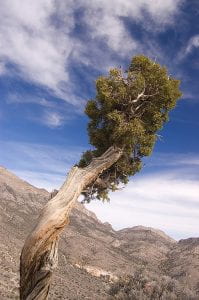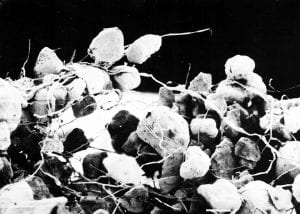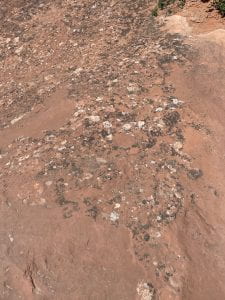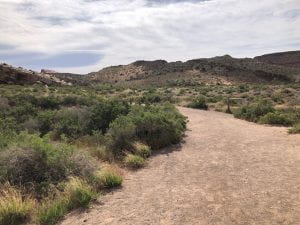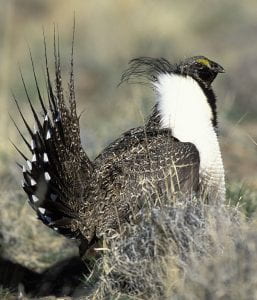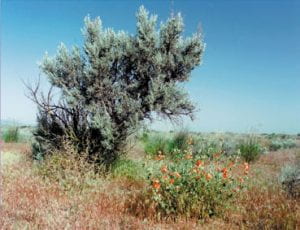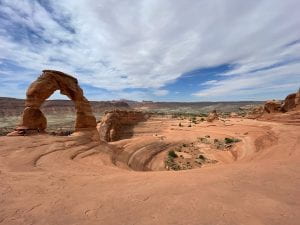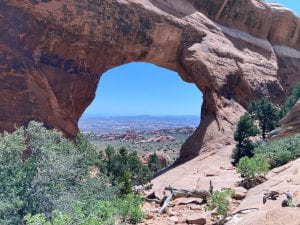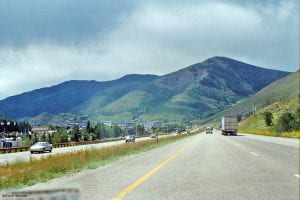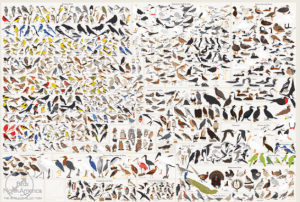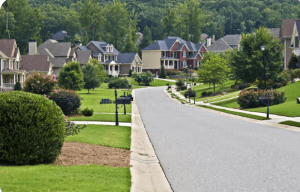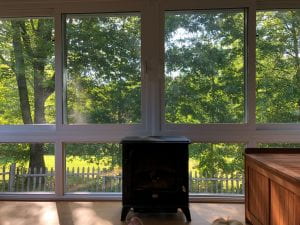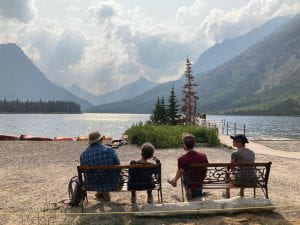(Click on the following link to listen to an audio version of this blog … Junipers and potholes )
Edward Abby had more than a couple of things to say about juniper trees in his book Desert Solitaire:
“The essence of the juniper continues to elude me unless, as I presently suspect, its surface is also its essence.”
“If a man knew enough he could write a whole book about the juniper tree. Not juniper trees in general but that one particular tree which grows from a ledge of naked sandstone near the old entrance to Arches National Monument.”
Junipers stand out against the rocky expanse of the Colorado Plateau steppes. Their deep, living green contrasts with the tans and red-browns of the sand and rocks and with the gray-greens of the scattered sagebrush. That they can live here on the edge of the desert, that they can exist where almost no other green thing can, is a story worth exploring. They stand, as Abby implied, at the edge of an infinite complexity of wonder!
There are two common species of juniper around Arches and Canyonlands National Parks: Utah juniper (Juniperus osteosperma) and one-seed juniper (J. monosperma). These two species resemble each other: both have short, straight trunks with spreading branches, very small, yellow-green, scale-like leaves (on adult trees) and light blue “berries” (which are really ripe, wax-encased, seed cones). On very young seedlings the leaves are green, needle-shaped and just under 1/2” long. One-seed juniper trees are usually smaller and bushier than Utah junipers. Also, their “berries” are usually slightly smaller. The two trees, though, are very difficult to tell apart, and, making absolute identification even more challenging, the two species also cross-pollinate and form intermediately configured hybrids.
These junipers can be between 10 and 26 feet tall, and, like sagebrush, have two types of root systems: a deep taproot that can be up to 25 feet long, and a shallow, spreading fibrous root system that can extend up to 100 feet around the plant. The tap root allows the juniper to access water from the underlying water table and the fibrous roots enable it to take up rainwater and snow melt before it gets into the deep water table. Interestingly, the fibrous root systems are inactive in the summer (a time when there are few rain events). Snow melt is probably the main source of water picked up by these shallow, fibrous roots.
Junipers grow very slowly and add only 0.05” to their trunk diameters each year. They are, however, very long-lived and can reach ages in excess of 650 years!
Junipers are mostly monecious (only one type of individual that has both pollen and ovulate cones). They begin to produce seeds at 30 years of age and, thereafter, make abundant seeds almost every year. Each “berry” contains one or two seeds. Many mammalian and avian species rely on juniper “berries” for food, and the juniper in turn relies on these consumers to transport and disperse the seeds and also scarify them. Juniper seeds germinate much more readily after they have passed through the intestines of a seed-eating mammal or bird.
Junipers also often have white berries growing among their dense branches. These are the fruits of two mistletoe species (juniper mistletoe (Phoradendron juniperum, ssp juniperum) and dense mistletoe (P. boleanum ssp densum)) which very commonly parasitize both Utah and one-seed junipers.
Junipers are most often are found growing with pinyon pines (Pinus edulis). These pinyon-juniper woodlands are quite productive and are expanding into formerly sagebrush areas primarily due to human activity (see Signs of Summer 6, June 23, 2022). Suppression of natural fires has allowed some sagebrush communities, which historically got “re-set” every few decades by burns, to develop into pinyon-juniper woodlands. And, the more intense and more frequent occurrence of modern wildfires (fueled by the presence of invasive species and the extended dryness and heat due to climate change) have wiped out unnaturally large areas of sagebrush leaving little chance of natural re-vegetation with seeds from the poorly transported sagebrush species.
Young juniper trees are very vulnerable to fire and are easily killed in even low intensity fires. Older, larger trees have some resistance to fire damage. Natural fires in pinyon-juniper woodlands have historically cycled over every 10 to 30 years.
Many small mammals (including desert cottontails, porcupines, deer mice, Great Basin pocket mice, desert woodrats and kangaroo rats), and reptiles (including collared lizards, plateau lizards and tree lizards) rely on pinyon-juniper woodlands for habitat. Also over 70 species of birds breed in pinyon-juniper woodlands including five species that locally do so obligatorily (screech owls, gray flycatcher, scrub jay, plain titmouse and gray vireo). Ferruginous hawks also nest in Utah juniper trees.
Large mammals (like mule deer, elk, bison, pronghorns, wild horses, mountain lions and lynx) also inhabit pinyon-juniper woodlands. These woodlands provide these species very important protective cover both in the summer and in the winter.
Juniper leaves are very poor quality browse. They are quite low in nutrients and have high levels of volatile oils which can poison a ruminant’s vital stomach microflora. In the winter, though, when browse is scare, mule deer do consume juniper foliage.
A very unusual feature of a juniper is its ability to prune back its own branches in order to conserve water. Most older juniper trees have large, dead branches still attached to the main, living trunk of the tree. The trees are able to shut down waterflow to those branches in order to keep sufficient water available for the rest of its tissues.
When we were out on the big, slick-rock expanse looking over the canyon at Grand View Point, I noticed a whole set of crust-lined concavities all across the rock. The depressions were between 3 and 8 feet long and each one was about half as wide as it was long. The largest of the “potholes” had depths of 4 or 5 inches below the rock-face surface at their deepest points with much shallower areas around their peripheries. All of them, though, regardless of size, were uniformly lined with similar-looking, flaky, greenish-gray coatings.
There were about 20 of these concavities immediately visible across the open rock face where I was standing but many more off in the more vegetated (juniper trees and black-brush clumps, primarily) edges of the rock. There were a very large number of these concavities, then, all along the rocky top rim of this canyon!
Using some very rusty geometry, I calculated that the larger holes had individual volumes of about 31 gallons (or 117 liters), and that the smaller ones were closer to ten gallons (or 38 liters). All of the depressions I could see had a summed volume of just over 400 gallons, but this volume represented just a fraction of the total potential pool size across the miles and miles of rock circling the top rim of the canyon. These little “potholes” could collectively hold a very large volume of water from snow melt or spring rains!
These potholes, when filled with water, are called “desert rock pools” or “freshwater rock pools.” They are the desert counterpart of the temporary, “vernal” pools found in the wet forests of the eastern part of North America (see Signs of Spring 10, April 28, 2016) or, maybe more accurately, miniature versions of the playa lakes of the southern plains (See Signs of Winter 4, December 24, 2020). They are extremely ephemeral bodies of water in a climate where water is the preeminent ecological limiting factor.
These rock pools are miniature, oligotrophic (“low nutrient”) ponds. Nutrients in them can only come from air-borne organic materials or from feces deposited by terrestrial animals. Primary productivity (photosynthesis) in the pools is quite limited and for the most part carried out by cyanobacteria. As we saw in biological soil crusts, cyanobacteria are able to survive severe desiccation and can rehydrate quickly back into fully functional, photosynthesizing cells. The bottom crusts of the dried pools are, for the most part, cyanobacteria residues. We should also note that, like the cyanobacteria residues in biological soil crusts, these rock pool residues are very susceptible to compression damage! Walking or wading through one of these pools can do a great deal of lasting damage to these vital bacteria.
When one of these pools fills with water a number of species of crustaceans, flatworms, rotifers, mites and tardigrades rush to complete their life cycles. As the water evaporates, these organisms, if they have developed quickly enough, sink back into their drought resistant life stages (eggs, larva or even adult forms) and bury themselves in the dry, protective crust of the pool’s sediment.
These “passive dispersing” life forms move from pool to potential pool by high, seasonal water flows or wind. Animals walking through the dried crusts can also transport the active or inactive life stages of these organisms from one pool site to another.
The pool also sustains a number of “active dispersing” species. These include many species of flies, midges and mosquitoes whose adult forms can fly from pool to pool to lay eggs. We were cautioned that in the early spring there are large numbers of biting midges out on the hiking trails of Arches and Canyonlands. These rock pools are, undoubtedly, one of the main sources of these organisms.
These pools are important signs of the overall health of these desert and dry steppe ecosystems. They are also quite important, in spite of their incredibly short-lived natures, in the early spring food chains for a number of bird and reptile species. The clouds of midges and mosquitoes to us humans are pests, but to a hungry, nesting, insectivorous bird or hunting lizard, they are mana from heaven (see Signs of Spring 13, May 19, 2015)!
I had a few more “Moab” topics that I wanted to write about, but five blogs (7500 words) about these Utah ecosystems seems like enough for now! Sometime in the future I will write about ravens and cliff swallows, packrats and quicksand, and yuccas, Mormon tea and prickly pears! I’ll also try to get all of the incredible plant pictures that Deborah and Marian took and identified, organized and published. Stay tuned!!



